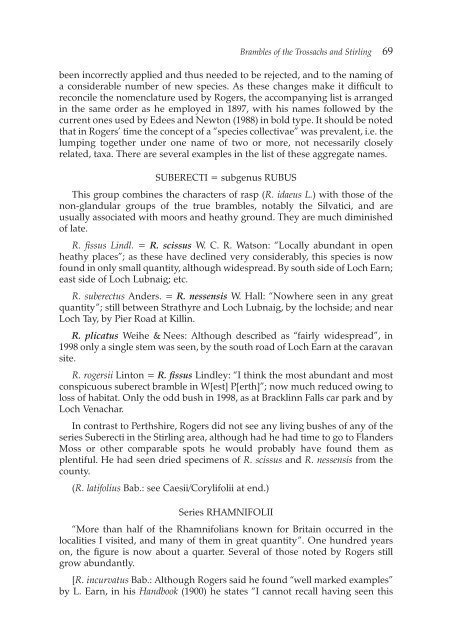the Forth Naturalist Historian - Forth Naturalist and Historian ...
the Forth Naturalist Historian - Forth Naturalist and Historian ...
the Forth Naturalist Historian - Forth Naturalist and Historian ...
You also want an ePaper? Increase the reach of your titles
YUMPU automatically turns print PDFs into web optimized ePapers that Google loves.
Brambles of <strong>the</strong> Trossachs <strong>and</strong> Stirling 69<br />
been incorrectly applied <strong>and</strong> thus needed to be rejected, <strong>and</strong> to <strong>the</strong> naming of<br />
a considerable number of new species. As <strong>the</strong>se changes make it difficult to<br />
reconcile <strong>the</strong> nomenclature used by Rogers, <strong>the</strong> accompanying list is arranged<br />
in <strong>the</strong> same order as he employed in 1897, with his names followed by <strong>the</strong><br />
current ones used by Edees <strong>and</strong> Newton (1988) in bold type. It should be noted<br />
that in Rogers’ time <strong>the</strong> concept of a “species collectivae” was prevalent, i.e. <strong>the</strong><br />
lumping toge<strong>the</strong>r under one name of two or more, not necessarily closely<br />
related, taxa. There are several examples in <strong>the</strong> list of <strong>the</strong>se aggregate names.<br />
SUBERECTI = subgenus RUBUS<br />
This group combines <strong>the</strong> characters of rasp (R. idaeus L.) with those of <strong>the</strong><br />
non-gl<strong>and</strong>ular groups of <strong>the</strong> true brambles, notably <strong>the</strong> Silvatici, <strong>and</strong> are<br />
usually associated with moors <strong>and</strong> heathy ground. They are much diminished<br />
of late.<br />
R. fissus Lindl. = R. scissus W. C. R. Watson: “Locally abundant in open<br />
heathy places”; as <strong>the</strong>se have declined very considerably, this species is now<br />
found in only small quantity, although widespread. By south side of Loch Earn;<br />
east side of Loch Lubnaig; etc.<br />
R. suberectus Anders. = R. nessensis W. Hall: “Nowhere seen in any great<br />
quantity”; still between Strathyre <strong>and</strong> Loch Lubnaig, by <strong>the</strong> lochside; <strong>and</strong> near<br />
Loch Tay, by Pier Road at Killin.<br />
R. plicatus Weihe & Nees: Although described as “fairly widespread”, in<br />
1998 only a single stem was seen, by <strong>the</strong> south road of Loch Earn at <strong>the</strong> caravan<br />
site.<br />
R. rogersii Linton = R. fissus Lindley: “I think <strong>the</strong> most abundant <strong>and</strong> most<br />
conspicuous suberect bramble in W[est] P[erth]”; now much reduced owing to<br />
loss of habitat. Only <strong>the</strong> odd bush in 1998, as at Bracklinn Falls car park <strong>and</strong> by<br />
Loch Venachar.<br />
In contrast to Perthshire, Rogers did not see any living bushes of any of <strong>the</strong><br />
series Suberecti in <strong>the</strong> Stirling area, although had he had time to go to Fl<strong>and</strong>ers<br />
Moss or o<strong>the</strong>r comparable spots he would probably have found <strong>the</strong>m as<br />
plentiful. He had seen dried specimens of R. scissus <strong>and</strong> R. nessensis from <strong>the</strong><br />
county.<br />
(R. latifolius Bab.: see Caesii/Corylifolii at end.)<br />
Series RHAMNIFOLII<br />
“More than half of <strong>the</strong> Rhamnifolians known for Britain occurred in <strong>the</strong><br />
localities I visited, <strong>and</strong> many of <strong>the</strong>m in great quantity”. One hundred years<br />
on, <strong>the</strong> figure is now about a quarter. Several of those noted by Rogers still<br />
grow abundantly.<br />
[R. incurvatus Bab.: Although Rogers said he found “well marked examples”<br />
by L. Earn, in his H<strong>and</strong>book (1900) he states “I cannot recall having seen this



